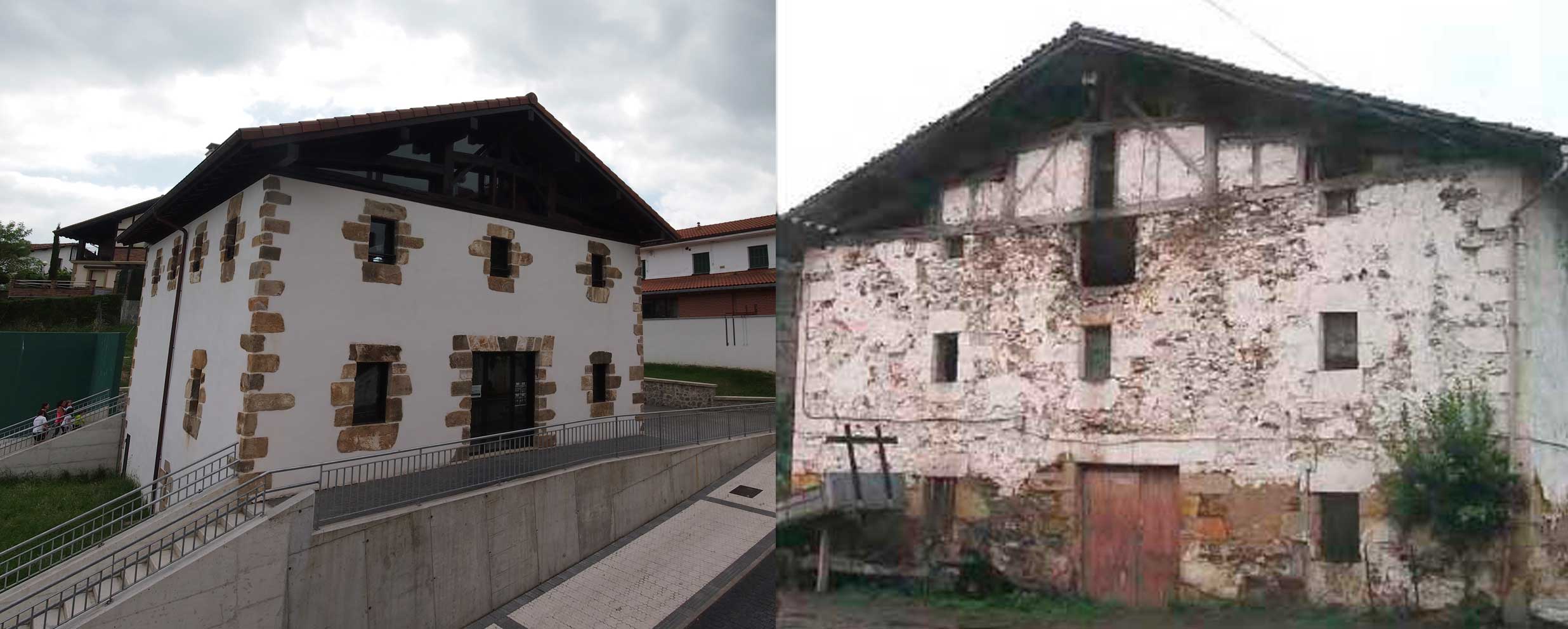


Ihurre zaharreko eraikin berria Olaberriako hirigunean kokatzen da, udaletxearen alboan.
Bi mila eta hamabigarren urtean zaharberritze bat burutu zitzaion, jatorrizko baserriaren elementuen zati handi bat erabiliaz, honek eman zion gaur egun duen izena. Hasiera batean ibai terraza batean kokatzen zen, errepide nazionala eta Oria ibaiaren artean, zeinek Idiazabalekin muga bereizten duen.
Eraikuntza primitiboa baino txikiagoa da, hala ere, honen leihoen harlanduak eta izkinakoak mantentzen ditu, teilatu azpiko egurrezko estrukturaren zati handi batekin batera.
Jatorrizko eraikinaren ondaredun izaera memorian mantentzeko asmoz, idurreko parajea, eta zehatzago bere burdinola, 1469. urtean aipatuak izan zirela nabarmentzen da. Bere bizitzan zehar, baserri hau izen bereko ekoizpen taldeari lotuta azaltzan da. Gipuzkoako burdinola garrantzitsuenetako bat, errota bat eta beste zenbait jabetza zeuzkan, hasiera batean Lazkano leinuari, eta ondoren Valdemiano markesari lotuta.
Burdingintza etxe eginkizuna eman zitzaion etxe honi.
XVI. mende hasieran, 1507an, “Yurre” izeneko baseeri baten lehen zantzuak ageri dira, berriki erretakoa eta ondorioz birreraiki behar izango zena. Mende horretako erdialdean Olaberriako 24 etxe garrantzitsuenetariko bat izatera pasa zen., 1565ean.
Hala ere, dirudienez Ihurre Zaharren azken itxura XVII. mendean zehar eginiko berritzeren baten ondorio da.
Baserri hau modu ezberdinez izendatua izan da historian zehar: Yurre (1469); Yhurre (1507); Hiurre (1609); Yurre de abajo (1762); Yurrezarra (1863).
El nuevo edificio de Ihurre Zaharra se ubica en el casco urbano de Olaberria, junto al ayuntamiento.
Debe su nombre a que para la reconstrucción del mismo, ejecutada en el año 2012, han sido utilizados gran parte de los elementos constructivos del originario caserío Ihurre Zaharra, el cual se asentaba en una amplia terraza fluvial, entre la carretera nacional I y el río Oria, que hace las veces de límite con el término municipal de Idiazabal.
Este edificio de dimensiones menores que el primitivo, posee los sillares de las ventanas y esquineros del edificio original, así como una parte importante de la estructura de madera del bajo cubierta.
Con la finalidad de preservar en la memoria el carácter patrimonial del edificio original, se señala que el paraje de Ihurre, y más en concreto su ferrería, ya aparece mencionado en el año 1469. Durante buena parte de su existencia este caserío aparecerá ligado al conjunto productivo de su mismo nombre, compuesto por una de las más importantes ferrerías del territorio guipuzcoano junto a un molino y otras propiedades anexas ligadas al linaje de los Lazcano y posteriormente al del marqués de Valmediano.
Se le atribuye a esta casería la función de casa del ferrón.
A principios del siglo XVI, en 1507, se evidencia ya la presencia de un caserío denominado “Yurre”, el cual se había quemado recientemente y que por lo tanto deberá ser reconstruido. A mediados de ese mismo siglo la casería aparecerá incluida formando parte de las veinticuatro casas solariegas o principales de Olaberria (1565).
A pesar de lo señalado, la última traza del caserío Ihurre Zaharra parece ser que fue fruto de una reconstrucción posterior llevada a cabo en algún momento del siglo XVII.
La casería aparece mencionada históricamente de diferentes maneras: Yurre (1469); Yhurre (1507); Hiurre (1609); Yurre de abajo (1762); Yurrezarra (1863).
The new building of Ihurre Zaharra is located in the center of the town, close to the city hall.
It was given this name due to the refurbishment it suffered in 2012, in which a great amount of the constructive elements of the original “Baserri” where used. In the very beginning, this farm used to be located in a wide fluvial terrace, between the national highway and the Oria river, just in the limit with the village of Idiazabal.
The new building of Ihurre Zaharra is smaller in dimension than its primitive version. It conserves the ashlars of the windows, together with an important part of the wooden structure of the roof.
Aiming to preserve the patrimonial nature of the building, it is remembered that first references to it are from 1469, when its setting, and specially its ironworks are mentioned. During its existence, this farm was always bounded to the production set of its same name, formed by one of the most important ironworks of Gipuzkoa, a mill, and some other properties, bound to the Lazcano lineage at first, and to the marquis of Valmediano after.
Some evidence from the beginning of the XVIth century tells that there was already a farm called “Yurre”, that had been burnt and was going to be refurbished. In the middle of this same century, the house had been recognized to be between the 24 most important houses of Olaberria (1565).
However, the aspect that Ihurre Zaharra has nowadays seems to be consequence of a reconstruction that was carried out during the XVIIth century.
People have referred to the house in different ways through history: Yurre (1469); Yhurre (1507); Hiurre (1609); Yurre de abajo (1762); Yurrezarra (1863).



